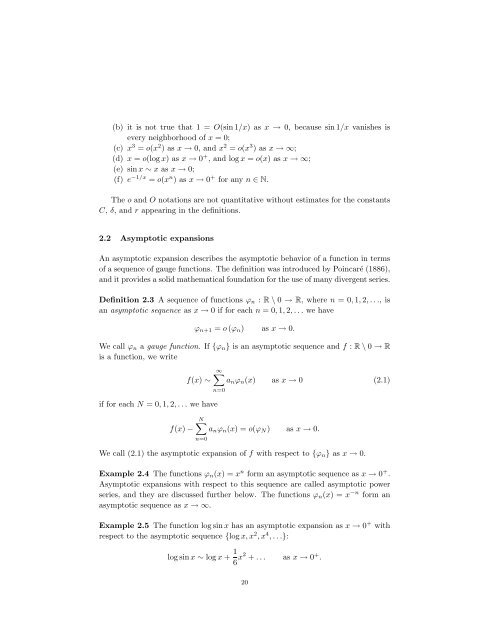Asymptotic Analysis and Singular Perturbation Theory
Asymptotic Analysis and Singular Perturbation Theory
Asymptotic Analysis and Singular Perturbation Theory
You also want an ePaper? Increase the reach of your titles
YUMPU automatically turns print PDFs into web optimized ePapers that Google loves.
(b) it is not true that 1 = O(sin 1/x) as x → 0, because sin 1/x vanishes is<br />
every neighborhood of x = 0;<br />
(c) x 3 = o(x 2 ) as x → 0, <strong>and</strong> x 2 = o(x 3 ) as x → ∞;<br />
(d) x = o(log x) as x → 0 + , <strong>and</strong> log x = o(x) as x → ∞;<br />
(e) sin x ∼ x as x → 0;<br />
(f) e −1/x = o(x n ) as x → 0 + for any n ∈ N.<br />
The o <strong>and</strong> O notations are not quantitative without estimates for the constants<br />
C, δ, <strong>and</strong> r appearing in the definitions.<br />
2.2 <strong>Asymptotic</strong> expansions<br />
An asymptotic expansion describes the asymptotic behavior of a function in terms<br />
of a sequence of gauge functions. The definition was introduced by Poincaré (1886),<br />
<strong>and</strong> it provides a solid mathematical foundation for the use of many divergent series.<br />
Definition 2.3 A sequence of functions ϕn : R \ 0 → R, where n = 0, 1, 2, . . ., is<br />
an asymptotic sequence as x → 0 if for each n = 0, 1, 2, . . . we have<br />
ϕn+1 = o (ϕn) as x → 0.<br />
We call ϕn a gauge function. If {ϕn} is an asymptotic sequence <strong>and</strong> f : R \ 0 → R<br />
is a function, we write<br />
f(x) ∼<br />
if for each N = 0, 1, 2, . . . we have<br />
f(x) −<br />
∞<br />
anϕn(x) as x → 0 (2.1)<br />
n=0<br />
N<br />
anϕn(x) = o(ϕN) as x → 0.<br />
n=0<br />
We call (2.1) the asymptotic expansion of f with respect to {ϕn} as x → 0.<br />
Example 2.4 The functions ϕn(x) = x n form an asymptotic sequence as x → 0 + .<br />
<strong>Asymptotic</strong> expansions with respect to this sequence are called asymptotic power<br />
series, <strong>and</strong> they are discussed further below. The functions ϕn(x) = x −n form an<br />
asymptotic sequence as x → ∞.<br />
Example 2.5 The function log sin x has an asymptotic expansion as x → 0 + with<br />
respect to the asymptotic sequence {log x, x 2 , x 4 , . . .}:<br />
log sin x ∼ log x + 1<br />
6 x2 + . . . as x → 0 + .<br />
20
















